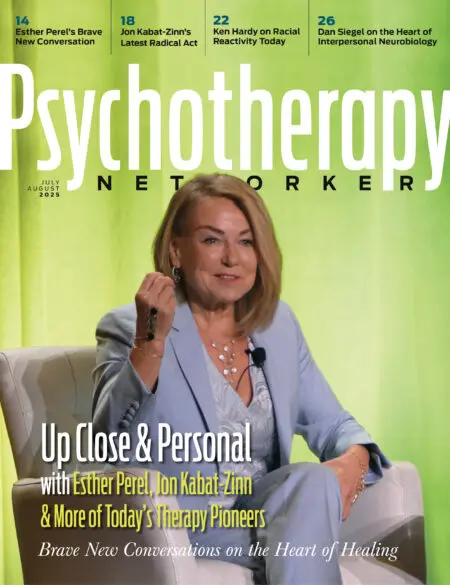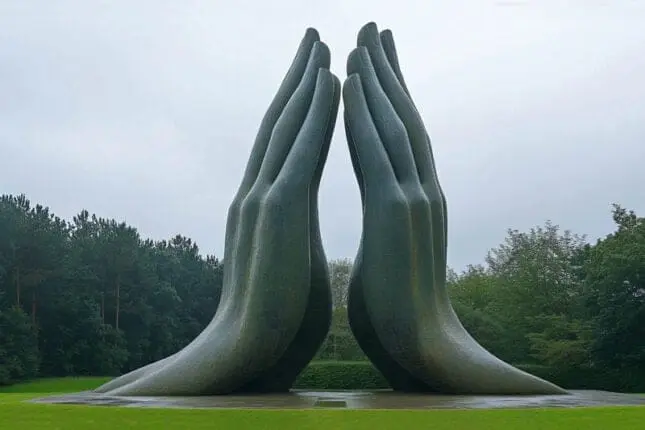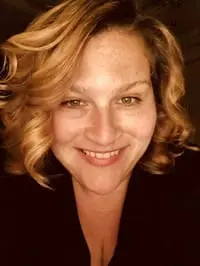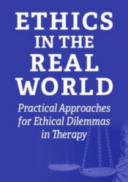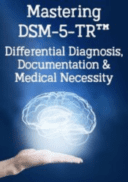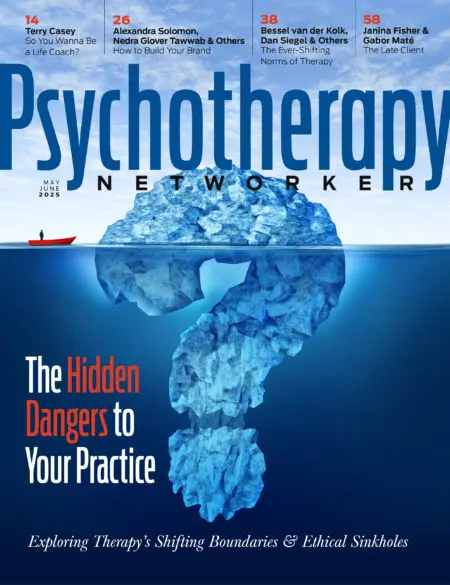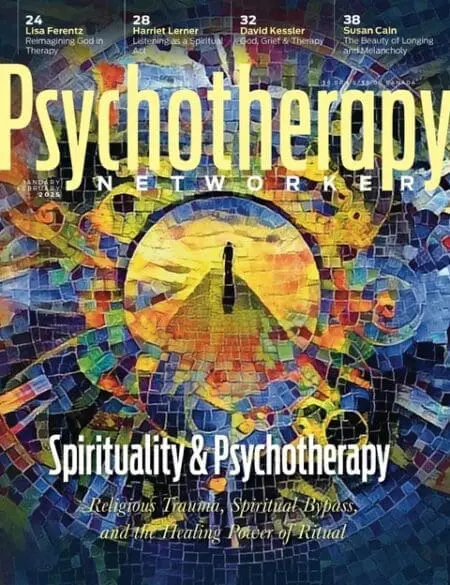“What are you noticing now?” my EMDR therapist, Janet, asked me after the initial bilateral stimulation sequence during our first reprocessing session. “That God won’t give me any more than I can handle,” I replied earnestly. “God is in control.”
“Uh, go with that,” she said. As EMDR therapists are trained to do, she wasn’t censoring any content unless it became clear that I was stuck.
This was the summer of 2004, and the way I saw the teenagers treated in the psychiatric hospital where I interned had triggered my own unhealed trauma about having my childhood wounds denied. After two years of continuous sobriety, which I credit to working a 12-step program, it became clear that there was more work to be done. Dissociating from my own life in problematic ways remained the norm for me. I wanted to stay sober, yet in many ways I still wanted to die.
Now, I was processing one of the most significant developmental traumas of my life, and my head was filled with lines like, Let go and let God and I have to forgive them, for they know not what they’re doing. With these comforting, albeit sometimes overly simplistic, recommendations I’d absorbed from the conservative religions of my childhood, I’d learned to accentuate what’s positive to stay afloat, even at the expense of ignoring pain. And if I did notice any pain, then the solution was just to pray on it, whatever “it” was.
“Jamie,” Janet intervened, with a tone that was both direct and nonjudgmental, “You’re allowed to go there now, into the pain. That’s why you’re here.”
Then the floodgates of my tears and my trauma recovery burst open. Something about her gentle permission to do the work helped me untangle the mixed messages from a lifetime of spiritual abuse and religious trauma.
As Janet and I continued to work together, I learned that I could be a person of deep faith: a person who prayed, called herself a Christian, and put responsibility in its proper place for the things that had happened to her. I could cry, I could shout my anger out to the God of my understanding. I didn’t have to forgive on autopilot to be a “good person” in the eyes of my family or the church. I could work through what I needed to work through, and then decide what forgiveness meant to me. Ultimately, I could even decide whether or not to grant forgiveness at all in order to heal.
What is Spiritual Bypass?
Spiritual bypass, a term originally coined by Buddhist teacher John Welwood in the 1970s, refers to a tendency to lean into a religious or spiritual practice, such as praying or meditating, instead of allowing oneself to feel the feelings and engage in the emotional work that’s needed to connect with pain and experience meaningful healing. When therapists hit a roadblock in working with spiritual or religious clients on their mental health goals, spiritual bypass may be a factor.
I’m not denying that religious beliefs and spiritual practices can support a person’s mental health and recovery. Prayer, meditation, having faith in something greater than oneself, singing or chanting, and worshipping in a community can be powerfully healing. But if these practices shut down emotional responses, they can clash with a client’s goals for therapy.
In my personal experience and my work with clients, I’ve noticed three main forms of spiritual bypass: toxic positivity, using spiritual or religious teachings to justify abuse, and believing suffering is a punishment for not praying or meditating enough or with sufficient devotion. Fortunately, there are several ways therapists can work with these forms of spiritual bypass to help clients honor their mental health and their spiritual inclinations.
Toxic positivity. Positive views, beliefs, or statements aren’t inherently toxic; many can even be psychological life rafts in difficult situations. The potential for toxicity lies in what they suppress and how strongly they suppress it. For instance, in 12-step recovery, the gratitude lists I made were a helpful way of cultivating a strengths-based mindset and broad perspective, but this practice could’ve easily become problematic if it had kept my focus exclusively on gratitude at times when it would’ve served me better to set boundaries with abusive people in my life, including certain religious leaders.
My healing journey from childhood trauma shifted when the simple words my therapist said—you’re allowed to go there—gave me permission to feel things that a religious context had blocked. But importantly, these words didn’t dismiss or disrespect my belief system, which would’ve created an even bigger block to my healing than spiritual bypass had.
When a client doesn’t feel judged, therapists can more easily pivot to a motivational interviewing-style of questioning: “On the one hand, you have these beliefs about focusing on the good in everyone, and they’ve served you well in many situations. On the other hand, you’ve said your goals for therapy involve working through the pain of your ex’s treatment of you. Are you seeing the clash here?”
When good teachings enable bad things. As therapists, we can help clients identify the beautiful teachings in a religious or faith tradition while acknowledging that virtually anything can get twisted to justify abuse. “Honor thy father and thy mother,” from the Ten Commandments, is an example of a beautiful and often misused teaching. Sure, there’s tremendous value in honoring our parents by understanding who they are, how they were raised, and what led them to behave toward us as they did. But when “honoring our parents” means denying our painful childhood experiences, then we can easily become stuck in our trauma.
In addition to growing up as a conservative Catholic (from Mom) and a Pentecostal Evangelical (from Dad), I spent time studying yoga in ashrams, where I saw how beautiful spiritual teachings like ones that distinguish the capital-S Self from the lower-case self, thereby allowing us to tap into a felt sense of our universal nature, can be used by some to discourage dissent in communities. In particular, people who call out abuse may be accused of promoting division or dismissed as reacting from a “lower self” mired in the past. And in religious communities, there’s a widely held view that those who embody their Highest Self always forgive, even when abuse is involved.
Of course, it’s important to maintain a nonjudgmental space in which a client can come to their own conclusions about what serves them best. For example, my client Janelle could barely function because of spiraling depression and anxiety. In our first session, I wondered out loud how her feelings of failing her Autistic child when he was dysregulated and out of control were affecting other aspects of her life, like her ability to connect with others and meet deadlines at work.
She told me, “My feelings don’t matter, because I am not my feelings,” a way that many people interpret the yogic teaching of disidentification. When I asked her to help me understand the teaching a bit better, she replied, “Well, I might have feelings of helplessness and failure, but they don’t mean anything. They’re just an illusion, like clouds, blocking our view of our true Self. I’m trying to bring my Self to my parenting, but I get too caught up in my own stuff and plummet into the quicksand.” When I gently wondered where in that teaching it said that her feeling didn’t matter, she began to open to the work of sitting with her feelings rather than escaping them.
How we intervene matters—it can either elicit defensiveness about their spiritual teacher or tradition or deepen our client’s curiosity.
Pray on it more. Many religious or spiritual clients have concluded that their suffering must mean they’re not “enough” of what God wants. I’ve heard clients say things like, “I’m just not praying on it enough,” or “My minister told me I don’t need 12 steps; I just need one step: God.” Believing they’re falling short of a spiritual expectation can become an endless source of self-blame, and it can give them an illusory sense of control.
I often ask these clients, “Would you consider that perhaps if the greatest power of prayer lies in asking God to lead us to the help we need, then the help might arrive in the form of therapy? It might arrive in moments when we recognize and accept our humanity and vulnerability. Or it might take the form of feeling supported by others who give us permission to feel whatever we feel without judgment.”
In the therapeutic relationship, we can help people see how two seemingly contradictory things—our emotions and our spirituality—are not at odds with one another. Both can be real at the same time. We can engage in the work we need to do as humans to heal—and we can remain connected to the divine. One can help us better understand the other, if we allow it.
Jamie Marich
Jamie Marich, PhD, LPCC-S, REAT (she/they), is the founder of the Institute for Creative Mindfulness EMDR Therapy training program. Marich is the author of over 10 books on trauma, recovery, and the expressive arts, most recently Dissociation Made Simple: A Stigma-Free Guide to Embracing Your Dissociative Mind and Navigating Life (which has an accompanying flipchart) and You Lied to Me About God: A Memoir, which relays Marich’s personal journey with spiritual abuse. Contact: http://www.jamiemarich.com.
